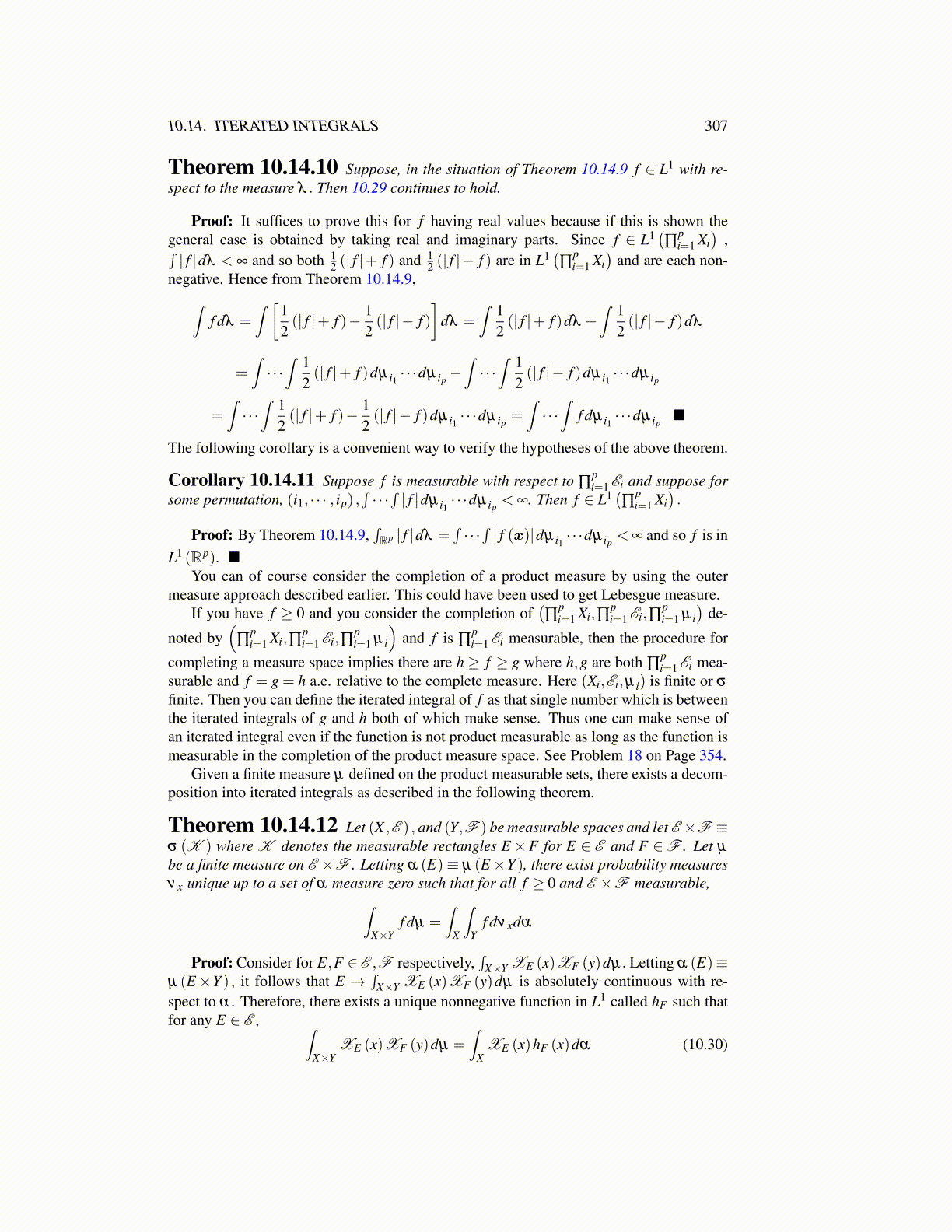
10.14. ITERATED INTEGRALS 307
Theorem 10.14.10 Suppose, in the situation of Theorem 10.14.9 f ∈ L1 with re-spect to the measure λ . Then 10.29 continues to hold.
Proof: It suffices to prove this for f having real values because if this is shown thegeneral case is obtained by taking real and imaginary parts. Since f ∈ L1
(∏
pi=1 Xi
),∫
| f |dλ < ∞ and so both 12 (| f |+ f ) and 1
2 (| f |− f ) are in L1(∏
pi=1 Xi
)and are each non-
negative. Hence from Theorem 10.14.9,∫f dλ =
∫ [12(| f |+ f )− 1
2(| f |− f )
]dλ =
∫ 12(| f |+ f )dλ −
∫ 12(| f |− f )dλ
=∫· · ·∫ 1
2(| f |+ f )dµ i1 · · ·dµ ip
−∫· · ·∫ 1
2(| f |− f )dµ i1 · · ·dµ ip
=∫· · ·∫ 1
2(| f |+ f )− 1
2(| f |− f )dµ i1 · · ·dµ ip
=∫· · ·∫
f dµ i1 · · ·dµ ip■
The following corollary is a convenient way to verify the hypotheses of the above theorem.
Corollary 10.14.11 Suppose f is measurable with respect to ∏pi=1 Ei and suppose for
some permutation, (i1, · · · , ip) ,∫· · ·∫| f |dµ i1 · · ·dµ ip
< ∞. Then f ∈ L1(∏
pi=1 Xi
).
Proof: By Theorem 10.14.9,∫Rp | f |dλ =
∫· · ·∫| f (x)|dµ i1 · · ·dµ ip
< ∞ and so f is inL1 (Rp). ■
You can of course consider the completion of a product measure by using the outermeasure approach described earlier. This could have been used to get Lebesgue measure.
If you have f ≥ 0 and you consider the completion of(∏
pi=1 Xi,∏
pi=1 Ei,∏
pi=1 µ i
)de-
noted by(
∏pi=1 Xi,∏
pi=1 Ei,∏
pi=1 µ i
)and f is ∏
pi=1 Ei measurable, then the procedure for
completing a measure space implies there are h ≥ f ≥ g where h,g are both ∏pi=1 Ei mea-
surable and f = g = h a.e. relative to the complete measure. Here (Xi,Ei,µ i) is finite or σ
finite. Then you can define the iterated integral of f as that single number which is betweenthe iterated integrals of g and h both of which make sense. Thus one can make sense ofan iterated integral even if the function is not product measurable as long as the function ismeasurable in the completion of the product measure space. See Problem 18 on Page 354.
Given a finite measure µ defined on the product measurable sets, there exists a decom-position into iterated integrals as described in the following theorem.
Theorem 10.14.12 Let (X ,E ) , and (Y,F ) be measurable spaces and let E ×F ≡σ (K ) where K denotes the measurable rectangles E×F for E ∈ E and F ∈F . Let µ
be a finite measure on E ×F . Letting α (E)≡ µ (E×Y ), there exist probability measuresνx unique up to a set of α measure zero such that for all f ≥ 0 and E ×F measurable,∫
X×Yf dµ =
∫X
∫Y
f dνxdα
Proof: Consider for E,F ∈ E ,F respectively,∫
X×Y XE (x)XF (y)dµ. Letting α (E)≡µ (E×Y ) , it follows that E →
∫X×Y XE (x)XF (y)dµ is absolutely continuous with re-
spect to α . Therefore, there exists a unique nonnegative function in L1 called hF such thatfor any E ∈ E , ∫
X×YXE (x)XF (y)dµ =
∫X
XE (x)hF (x)dα (10.30)